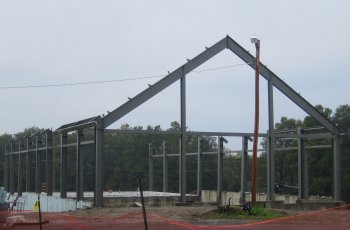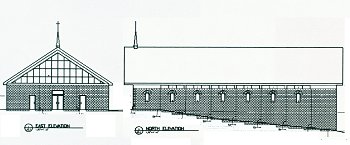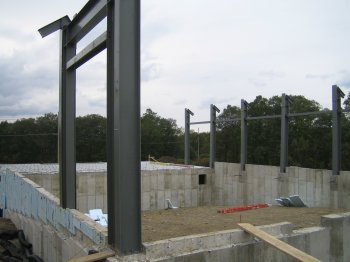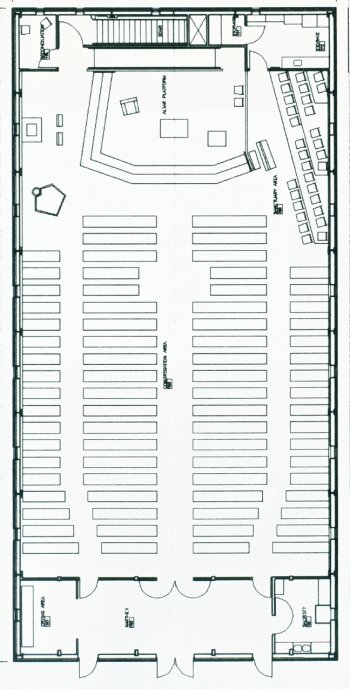- By Dan Veaner
- Around Town
 Print
Print
All Saints Catholic Church and Lansing United Methodist Church (LUMC) have a lot in common. They are just down the street from each other. They often conduct programs and events together. Each has a thriving, family-oriented community within their congregations. They are very successful in the sense that they are growing. And both are struggling with their success.

Steel framing goes up at All Saints
The struggle comes because the two congregations have become too big for their church buildings. And they are each taking a different approach, in part due to circumstances. LUMC has gone to two Sunday services. All Saints is building a new church. Each approach presents challenges for the congregations, who find themselves having to do something to handle their current numbers and encourage future growth.
All Saints was able to conduct two masses last year, but with a shared priest, it is not possible this year. "There's a great deal of difficulty trying to coordinate two services and religious ed at the same time," says the church's Administrative Assistant Dave Lippert. "We knew it was a means to an end. We've never lost sight of the fact that we wanted to return to one mass."

Three doors enter the narthex, with a huge window above
Seven stained glass windows will adorn each side of the church
With a full time pastor, LUMC is able to conduct two services. While this is the more economical choice, the congregation is struggling with just the problems Lippert outlines, because its members are very close-knit. Splitting it up disrupts that sense of community. Even with community time between services, people are missing familiar faces. But with their priest shared with Saint Anthony's in Groton, and Holy Cross in Dryden/Freeville, All Saints no longer has the luxury of splitting their service.
A study in 2000 released by the National Conference of Catholic Bishops found that 27% of U.S. parishes do not have a resident priest. The ratio of priests to people iin 1900 was 1:900, but today it is 1:1200. There are 433 priests over the age of 90 and 298 priests under the age of 30. So modern bishops are faced with serious challenges when assigning priests. And the congregations have to do the best they can with the resources they have.

Grading shows the incline for permanent pews.
That's what All Saints has set out to do. Construction began on a new $1.7 million church this year, and this week the steel started going up. It's capacity will be 400 people, up from 249 in the old church. With a congregation made up of more than 260 families, the new building will also free space in the other buildings to add classroom space for a burgeoning religious education program. The price includes furnishings for the building.
As you enter through the narthex, a room to the left is designated as a crying area for parents to bring crying babies. The sacristy, where the priest prepares for the mass, is on the right. Entering the sanctuary, permanent pews are arranged on a gradual incline, to make it easier to see. Movable seating will comprise the front five rows between the permanent pews and the altar.
The back of the sanctuary is on a level with the raised alter at the front. A baptismal area is to the left, and behind the alter on the left is a reconciliation room for confession. A storage room is to the right behind the altar, and more storage will be available in a basement below the altar area. "The aim is to have seven stained glass windows on each side," Lippert says. "There will be a large window above the front and back of the building. In the future we're talking about the one over the alter being partially if not all stained glass."
Lippert says the congregation has been involved in a transparent decision making process, which gets everyone invested in the project. And they have been generous about donating and raising money for the project. ""We've had a very active group of people under the leadership of Jerry Haas, Dan Brown, and Jerry Dwyer, amongst others, who have really done a lot to facilitate the financial side of this," he says. But there have been unexpected challenges. "We put our bids out just before Hurricane Katrina, and they came in after Hurricane Katrina," Lippert continues. "You could definitely see the impact of Hurricane Katrina on the cost of construction."
Compromises had to be made. "Some of it was decorative, some of it was design," Lippert says. "There was a different roof line on the building. The building was rounded out at the alter end. So what we had to do was go with a little more conventional construction and hope that we could bring it in. Our parishioners have been very generous. We've gone to them with the overrun, and they are responding."

Lippert says All Saints has seen explosive growth over the last three or four years, and the expectation is that it will continue. He says this is due to three phenomena. As a family oriented parish, All Saints is uniquely matched to a growing Lansing. Second, he says that families like their children to go to a church with their peers from school. And third, people moving to a new home include 'parish shopping' in their decision about where to live. "People come in, they look at a house, they look at the church, they look at the school, and then they decide whether to live here," Lippert says. "They'll look at a house, but then they'll shop for those other things. They've got to get the package all together."
Lippert says he thinks the new building will also contribute to the congregation's growth. "I've heard people say, 'Well, we don't come out there because there's just no room.' Well, there will be room. So we expect this growth to continue. When you've got a growing community with young people, and you have a viable religious ed program and a youth group, it's going to happen."
And the old church will still be used. By moving administrative offices to the back of the building, more space in the parish center will be available for Sunday school classrooms. The front will still be used for weekday masses and smaller events. So All Saints parishioners have some breathing room to look forward to in the near future, while they continue to grow. "We firmly believe that is going to continue to happen," says Lippert. Soon they will have room to do it.
----
v2i38

Steel framing goes up at All Saints
The struggle comes because the two congregations have become too big for their church buildings. And they are each taking a different approach, in part due to circumstances. LUMC has gone to two Sunday services. All Saints is building a new church. Each approach presents challenges for the congregations, who find themselves having to do something to handle their current numbers and encourage future growth.
All Saints was able to conduct two masses last year, but with a shared priest, it is not possible this year. "There's a great deal of difficulty trying to coordinate two services and religious ed at the same time," says the church's Administrative Assistant Dave Lippert. "We knew it was a means to an end. We've never lost sight of the fact that we wanted to return to one mass."

Three doors enter the narthex, with a huge window above
Seven stained glass windows will adorn each side of the church
With a full time pastor, LUMC is able to conduct two services. While this is the more economical choice, the congregation is struggling with just the problems Lippert outlines, because its members are very close-knit. Splitting it up disrupts that sense of community. Even with community time between services, people are missing familiar faces. But with their priest shared with Saint Anthony's in Groton, and Holy Cross in Dryden/Freeville, All Saints no longer has the luxury of splitting their service.
A study in 2000 released by the National Conference of Catholic Bishops found that 27% of U.S. parishes do not have a resident priest. The ratio of priests to people iin 1900 was 1:900, but today it is 1:1200. There are 433 priests over the age of 90 and 298 priests under the age of 30. So modern bishops are faced with serious challenges when assigning priests. And the congregations have to do the best they can with the resources they have.

Grading shows the incline for permanent pews.
That's what All Saints has set out to do. Construction began on a new $1.7 million church this year, and this week the steel started going up. It's capacity will be 400 people, up from 249 in the old church. With a congregation made up of more than 260 families, the new building will also free space in the other buildings to add classroom space for a burgeoning religious education program. The price includes furnishings for the building.
As you enter through the narthex, a room to the left is designated as a crying area for parents to bring crying babies. The sacristy, where the priest prepares for the mass, is on the right. Entering the sanctuary, permanent pews are arranged on a gradual incline, to make it easier to see. Movable seating will comprise the front five rows between the permanent pews and the altar.
The back of the sanctuary is on a level with the raised alter at the front. A baptismal area is to the left, and behind the alter on the left is a reconciliation room for confession. A storage room is to the right behind the altar, and more storage will be available in a basement below the altar area. "The aim is to have seven stained glass windows on each side," Lippert says. "There will be a large window above the front and back of the building. In the future we're talking about the one over the alter being partially if not all stained glass."
Lippert says the congregation has been involved in a transparent decision making process, which gets everyone invested in the project. And they have been generous about donating and raising money for the project. ""We've had a very active group of people under the leadership of Jerry Haas, Dan Brown, and Jerry Dwyer, amongst others, who have really done a lot to facilitate the financial side of this," he says. But there have been unexpected challenges. "We put our bids out just before Hurricane Katrina, and they came in after Hurricane Katrina," Lippert continues. "You could definitely see the impact of Hurricane Katrina on the cost of construction."
Compromises had to be made. "Some of it was decorative, some of it was design," Lippert says. "There was a different roof line on the building. The building was rounded out at the alter end. So what we had to do was go with a little more conventional construction and hope that we could bring it in. Our parishioners have been very generous. We've gone to them with the overrun, and they are responding."

Lippert says All Saints has seen explosive growth over the last three or four years, and the expectation is that it will continue. He says this is due to three phenomena. As a family oriented parish, All Saints is uniquely matched to a growing Lansing. Second, he says that families like their children to go to a church with their peers from school. And third, people moving to a new home include 'parish shopping' in their decision about where to live. "People come in, they look at a house, they look at the church, they look at the school, and then they decide whether to live here," Lippert says. "They'll look at a house, but then they'll shop for those other things. They've got to get the package all together."
Lippert says he thinks the new building will also contribute to the congregation's growth. "I've heard people say, 'Well, we don't come out there because there's just no room.' Well, there will be room. So we expect this growth to continue. When you've got a growing community with young people, and you have a viable religious ed program and a youth group, it's going to happen."
And the old church will still be used. By moving administrative offices to the back of the building, more space in the parish center will be available for Sunday school classrooms. The front will still be used for weekday masses and smaller events. So All Saints parishioners have some breathing room to look forward to in the near future, while they continue to grow. "We firmly believe that is going to continue to happen," says Lippert. Soon they will have room to do it.
----
v2i38



